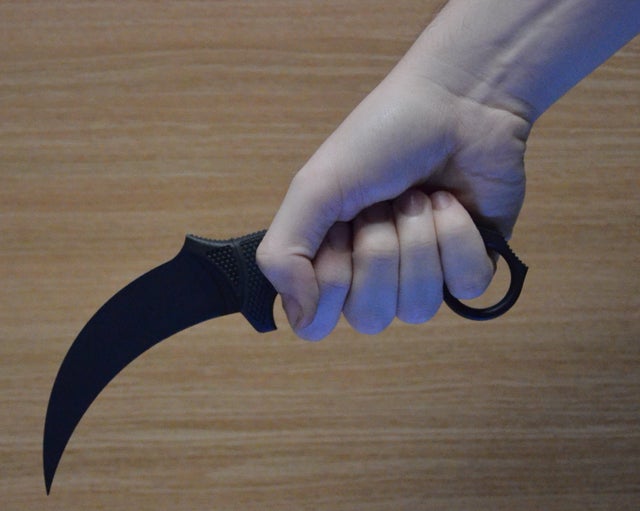EDC History: Karambit
Ashley 07.28.14

The small, curved-blade knife known as the Karambit occasionally pops up in popular culture. Fans of the Splinter Cell video games will certainly recognize it as one of Sam Fisher’s iconic weapons, and Karambits tend to be the weapon-of-choice for assassins or enemy agents in spy flicks. But despite their unique form–or perhaps because of it–Karambits haven’t seen much exposure in the greater EDC community. The Karambit is popular in some circles of martial arts, and its roots are in Indonesia, where the knife was created hundreds of years ago.
As EDC culture spreads, the Karambit isn’t as obscure as it once was. It’s a knife any knife aficionado should know a thing or two about. What distinguishes Karambits from other cultural pocket knives is its reputation as a defense tool. With the proper training, a Karambit can be a deadly, close-combat weapon.
History and Design
A Karambit–sometimes spelled Karembit or Korambit, and not always capitalized–is easily identified by its curved blade and handle that, all together, forms a half-moon shape. This alone makes it look more weapon-like than many smaller EDC knives. The shape is an homage to the shape of a tiger’s claw, and it served well during tasks like skinning fish or animal hide. Like most traditional knives, Karambits were originally fixed blades, but there are modern folding models available now.

Karambits originated in Indonesia from the “jungles of West Java” during the 11th century, according to the book Karambit: Exotic Weapon of the Indonesian Archipelago by Steve Tarani. Tarani is a Karambit historian and notable Karambit fighter.
Aside from the curved blade and handle, the Karambit is known for the safety ring on the end of the handle. A safety ring is not a necessity for a Karambit but, according to Karambit.com, the ring is part of the traditional Southeast Asian design.
The ring also serves several purposes:
The safety ring was originally designed to prevent the blade from sliding back through the user’s hand while working at odd angles, on difficult tasks or in specialized environments (like underwater or while hanging upside down). In battle, the safety ring provides a strong, sure hold in all conditions and through the most unexpected stressors. The karambit’s safety ring makes the knife exceptionally difficult to disarm or to turn against its user and it also allows the wielder to rely on the blade’s design for increased weapon retention instead of depending on grip strength alone. Whether the user’s hand is open or closed, moving or motionless, palm-up, palm-down or anywhere in between, due to the safety ring, a karambit knife is always secure and in an optimal position for use. Finally, the grip security and increased weapon retention is particularly valuable when the knife is covered in dust, mud, water or blood or when the karambit is being utilized at the difficult or precise angles required in combative application.
Karambits were made from a variety of materials, generally whatever was easiest to access in the Southeast Asia environment or what could be traded as the trade route through Asia flourished in the 11th-14th centuries. Nowadays, Karambits are made from different metals, most commonly steel.
Use in Combat
Although the knife is now associated closely with combat, the Karambit is also a tool like many traditional knives around the world. Despite its origins in Indonesia, other Asian cultures adopted the knife, including Malaysia and the Philippines, where the knife is called the “lihok.”
According to report about Filipino Karambits, “It was not meant to be used for combat since Karambit is first and foremost, a tool. It evolved only because of the necessity of the people of these three Asian countries to protect themselves from foreign invaders.” Karambit.com echoes this sentiment: “While the blade originally served solely as an ancient utility tool in the same vein as the modern-day ‘Swiss Army Knife,’ in the war-torn villages of Indonesian and the Philippines, the karambit readily lended itself to battlefield use.”
Despite its primary intention, the Karambit has become inextricably linked with combat and self-defense. Using knives as defense weapons is a polarizing topic in the gear community. Regardless, Karambit training is an extensive subculture, a large part as Pencat Silat, which refers to Indonesian martial arts. This video, by the Kali Research Academy, shows some traditional self-defense maneuvers using a Karambit.
Tarani writes about the necessity of Karambits during Indonesian wars:
During the fight for independence, Guru Besar Pendekar Uyuh Suwanda (my master’s father) and other Indonesian freedom fighters like him in the 1940’s, literally battled tooth and nail for the independence of their country. The personal combat system of these remarkable warriors was the indigenous and efficient fighting system of Indonesian Pencak Silat.
Where to Get One
If you want to add a Karambit to your collection, they’re not very hard to find, depending on the style you want. 5.11 Tactical Folding Karambit was designed by famous Karambit knife fighter and trainer Steve Tarani. It’s made in Taiwan, so it’s not an authentic Karambit, but it’s a good option for those who want a reliable Karambit for self-defense purposes. Knife Depot also sells an assortment of Karambits from various popular companies like Cold Steel and Smith and Wesson. Karambit.com showcases an array of custom Karambits, some with more traditional features.
There are a few ways to carry Karambits, not unlike most knives. It’s common to carry a Karambit in a pocket, in a sheath attached to a belt, or hung around the neck. In the United States, Karambits are legal to own and carry.